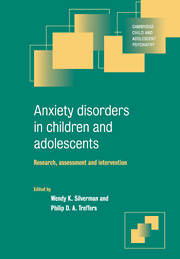Book contents
- Frontmatter
- Contents
- List of contributors
- Preface
- 1 Anxiety and its disorders in children and adolescents before the twentieth century
- 2 Affective and cognitive processes and the development and maintenance of anxiety and its disorders
- 3 Behavioural inhibition and the development of childhood anxiety disorders
- 4 Psychosocial developmental theory in relation to anxiety and its disorders
- 5 Neuropsychiatry of paediatric anxiety disorders
- 6 Clinical phenomenology, classification and assessment of anxiety disorders in children and adolescents
- 7 Friends or foes? Peer influences on anxiety among children and adolescents
- 8 Conditioning models of childhood anxiety
- 9 Traumatic events and post-traumatic stress disorder
- 10 Family and genetic influences: is anxiety ‘all in the family’?
- 11 Child–parent relations: attachment and anxiety disorders
- 12 Community and epidemiological aspects of anxiety disorders in children
- 13 Onset, course, and outcome for anxiety disorders in children
- 14 Psychosocial interventions for anxiety disorders in children: status and future directions
- 15 Pharmacological treatment of paediatric anxiety
- 16 Prevention of anxiety disorders: the case of post-traumatic stress disorder
- Index
13 - Onset, course, and outcome for anxiety disorders in children
Published online by Cambridge University Press: 25 March 2010
- Frontmatter
- Contents
- List of contributors
- Preface
- 1 Anxiety and its disorders in children and adolescents before the twentieth century
- 2 Affective and cognitive processes and the development and maintenance of anxiety and its disorders
- 3 Behavioural inhibition and the development of childhood anxiety disorders
- 4 Psychosocial developmental theory in relation to anxiety and its disorders
- 5 Neuropsychiatry of paediatric anxiety disorders
- 6 Clinical phenomenology, classification and assessment of anxiety disorders in children and adolescents
- 7 Friends or foes? Peer influences on anxiety among children and adolescents
- 8 Conditioning models of childhood anxiety
- 9 Traumatic events and post-traumatic stress disorder
- 10 Family and genetic influences: is anxiety ‘all in the family’?
- 11 Child–parent relations: attachment and anxiety disorders
- 12 Community and epidemiological aspects of anxiety disorders in children
- 13 Onset, course, and outcome for anxiety disorders in children
- 14 Psychosocial interventions for anxiety disorders in children: status and future directions
- 15 Pharmacological treatment of paediatric anxiety
- 16 Prevention of anxiety disorders: the case of post-traumatic stress disorder
- Index
Summary
Onset of anxiety disorders in children
There has been relatively little research interest focused on the age of onset and precipitating factors regarding anxiety disorders in children. Relatively more research has been done on these issues for adults, and thus both bodies of research are summarized in this chapter.
Age of onset in children
Table 13.1 summarizes studies in which information concerning age of onset for various childhood anxiety disorders has been found. Separation anxiety disorder, avoidant disorder and simple phobia seem to have the earliest age of onset.
Especially relevant are the recent studies by Biederman et al. (1997) and by Wittchen, Reed & Kessler (1998). Biederman et al. (1997) charted the mean ages of onset of anxiety disorders among children with panic disorder and agoraphobia. They examined 472 consecutively referred children and adolescents via a structured diagnostic interview. These children and adolescents were referred to a paediatric psychopharmacology clinic that did not specialize in the treatment of any particular disorder. Among children with agoraphobia the earliest anxiety disorder to emerge was specific phobia, followed by avoidance disorder and separation anxiety disorder; each of these disorders preceded the onset of agoraphobia. Overanxious disorder, social phobia and obsessive–compulsive disorder tended to follow the emergence of agoraphobia. Children with panic disorder showed a similar course, but they showed slightly later ages at onset for all the disorders. Agoraphobia had an earlier age at onset than panic disorder. This last finding was confirmed in the community study by Wittchen et al. (1998).
- Type
- Chapter
- Information
- Anxiety Disorders in Children and AdolescentsResearch, Assessment and Intervention, pp. 293 - 312Publisher: Cambridge University PressPrint publication year: 2000
- 5
- Cited by

